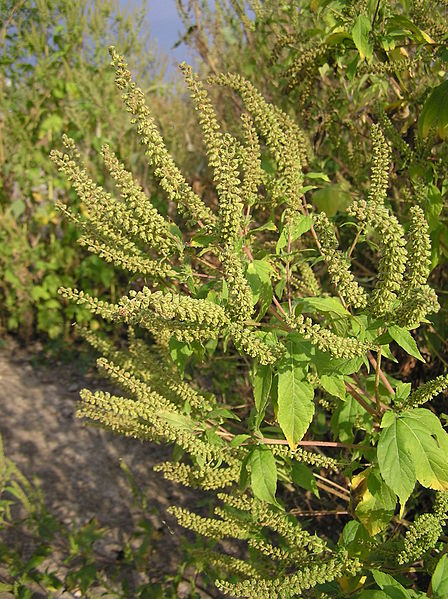Interaction
Lumbricus terrestris
directly interacts with many organisms and indirectly interacts with
even more. Earthworms are much more important than the average
person considers them to be because they not only aerate the soil
which allows minerals and CO2
to get to plants, but helps fertilize the soil from their castings.
In return, plants prosper which both directly and indirectly helps
all organisms living on Earth. This type of relationship can be
defined as commensalism (Martin 1951).
Commensalism is a symbiotic relationship in
which one organism benefits but the other is neither helped nor
harmed (Campbell 2008).
A mutualistic
relationship can be defined as a symbiotic relationship in which
both participants benefit (Campbell 2008). Earthworms have quite a
few mutualistic relationships, mainly with plants. One of the most
common is as followed:

The Giant Ragweed
As you have learned in the
Nutrition section, we know that L. terrestris surfaces at
night and will then take food back down into their burrows with
them. It just so happens that these earthworms also have a special
liking for seeds, especially giant ragweed seeds (Davis et al.
2008). Because these
earthworms also enjoy having a surplus of food down in their
burrows, there are usually many seeds that are forgotten about or
get fertilized before an earthworm eats food down in their burrows,
there are usually many seeds that are forgotten about or get
fertilized before an earthworm eats them (Griffith et al. 2013). Such is the case for the
ragweed seeds. In fact, ecologists have found that more than
two-thirds of all giants ragweeds seeds emerge from the burrows of
these earthworms (Davis et al. 2008). While the seeds can
certainly be thought of as food for this organism, L. terrestris
does much more help than harm to the overall population, causing a
mutualistic relationship.
A parasitic relationship,
on the other hand, is a symbiotic relationship in which one
organism, the parasite, benefits at the expense of another, the
host, by living either within or on the host (Campbell 2008).
Unluckily,
L. terrestris
also has a number of these relationships.
Monocystis
Unfortunately, the virtually defenseless
L. terrestris happens to be quite a
tasty treat for a numerous amount of organisms. In fact, there are
so many that it is nearly impossible to list all of them. These
organisms range from birds to fish to turtles and snakes.
 American Robin
American Robin
When you think about predators to the
earthworm, one of the first that often comes to mind is the robin.
The robin is a native bird to many areas that L. terrestris
is as well. You can often find them in spring in the early morning
on lawns where they are seen tugging earthworms out of the ground.
The earthworm is a plays crucial role in a robin's diet (Eastman
1997).
Walleye
 American Toad
American Toad
As the
name suggests, the
American Toad can be found in the United States. They often live
in habitats similar to that of the earthworm and can be found quite
often the common lawn or garden. Though these toads are not very
particular about their diet, earthworms top their along with
insects, spiders, and slugs (Martin 1951).
As many predators as
L. terrestris has, it also has an
extensive menu to chose from itself. More information on an
earthworm's prey can be found on the
Nutrition page, but some of the most common organisms consumed
include the Red Clover, American Sycamore, Red Maple, American Elm,
and Silver Maple leaves, Skunk Cabbage, and Kentucky Bluegrass
(Martin 1951).
Think you know it all? Test how your knowledge in our true and false section on our Facts page!
Check out where we gathered our information from on our Reference page
Home